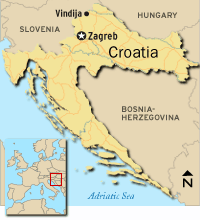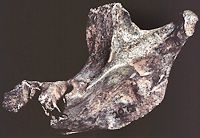|
By
Kenneth
Chang
ABCNEWS.com
Oct. 25 —
New dating of Neanderthal bones indicates that the
evolutionary cousins of modern humans survived later in
central Europe than had been thought and shared the
continent with their successors for several
millennia.

Anthropologists had
thought that Neanderthals had disappeared in an
east-to-west pattern across Europe but bones dated
to just 28,000 years ago from Vindija, Croatia in
central Europe refutes that idea.
(ABCNEWS.com)
|
The finding,
reported in Tuesday's issue of the Proceedings of
the National Academy of Sciences, overturns the
traditional notion that as modern humans spread from Africa
and the Middle East into Europe, they drove the supposedly
more primitive Neanderthals westward and eventually to
extinction.
European
Neighbors
"Into that picture come these Croatian dates which show
there were Neanderthals living in the hills of Croatia 3,000
years after there were early modern humans established in
Germany, a couple hundred kilometers away," says Erik
Trinkaus, an anthropologist at Washington University in St.
Louis and one of the paper's authors
The overlap in time and place
provides an opportunity for interbreeding between the two
species of hominids and the possibility that Neanderthal
genes persist to the present.
"Neanderthals may have been
driven to extinction in some areas," Trinkaus says,
"or they may have been absorbed into early modern human
populations in others,"
Neanderthals, primitive hominids
with prominent brows, coarse jaws and short legs, are
thought to have arisen in Africa more than 250,000 years
ago. They are thought to have appeared in Europe about
120,000 years ago and eventually to have been replaced by
modern humans.
Modern humans arrived in Europe at
least 32,000 years ago and possibly as early as 36,000 years
ago.
Newer
Dating
|

A jaw bone, about 3½ inches
long, one of the Vindija Neanderthal bones that was
dated.
(Croatian Academy of Sciences)
|
Trinkaus and his collaborators examined
Neanderthal bones originally dug up from a Croatian cave a
century ago. Radiocarbon dating on pill-size samples from
two skulls put their age at 28,000 years old. The
Neanderthal specimens had earlier been dated at 45,000 years
using a less accurate method.
"It just makes the picture of
the relationship between modern humans and Neanderthals far
more complicated than it was before," comments Jan
Simek, head of the anthropology department at University of
Tennessee, Knoxville. "You're not talking about
one advanced form and an animal. They were all
people."
The notion that Neanderthals and
humans interbred remains a controversial one, however.
"You could argue that they lived apart in the same area
and threw rocks at each other instead of genes," says
Clark Howell of the University of California, Berkeley.
Europeans a
Mixed Breed?
Trinkaus and lead author Fred Smith of Northern Illinois
University point to 25,000-year-old remains of a human child
found in Portugal whose legs, arms, teeth and skull show
Neanderthal-like characteristics.
"Our interpretation of that
… these populations were intermixed and these traits
persisted over a number of generations," Trinkaus says.
"It tells us that interbreeding took place."
Smith and Trinkaus say there are
body features in bones from 30,000-year-old human specimens
that suggest a Neanderthal contribution to the European gene
pool.
Others such as Howell say the
characteristics in the skeletons that Trinkaus and Smith
attribute to Neanderthal are within the range of normal
variations for humans.
Tests on Neanderthal DNA have
suggested it is too different to be human, but that
assertion is also controversial.
There is as yet no definitive
evidence of Neanderthals and humans being at exactly the
same place at the same time.
"We don't have evidence
of them directly meeting or coming into contact with each
other in Croatia or southern Germany," Trinkaus says.
"But we know they weren't all that far apart at
the same time."
The Associated Press contributed to this
report.

|

|
"You're not talking about one advanced form and an
animal. They were all people."
Jan Simek, University of Tennessee,
Knoxville
|